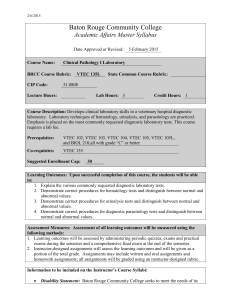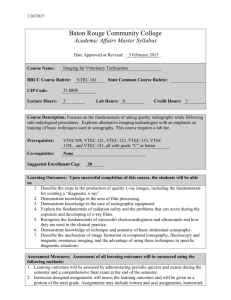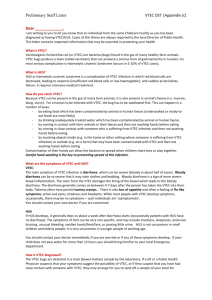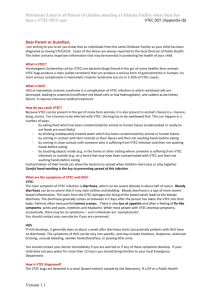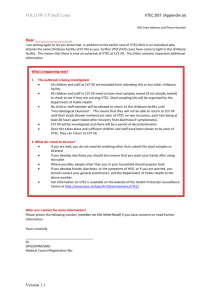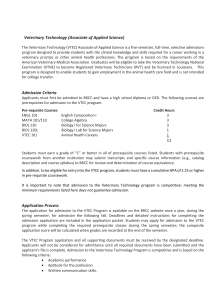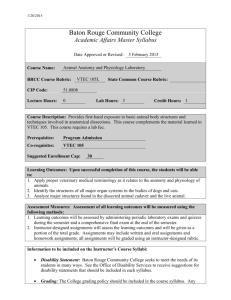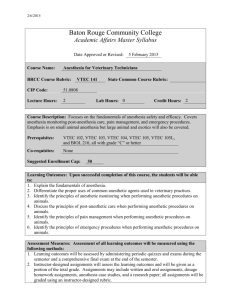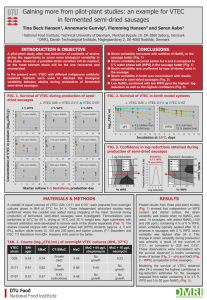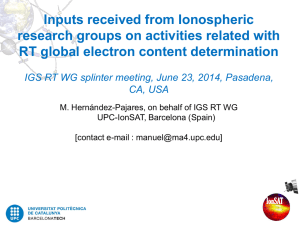Appendix D - Health Protection Surveillance Centre
advertisement
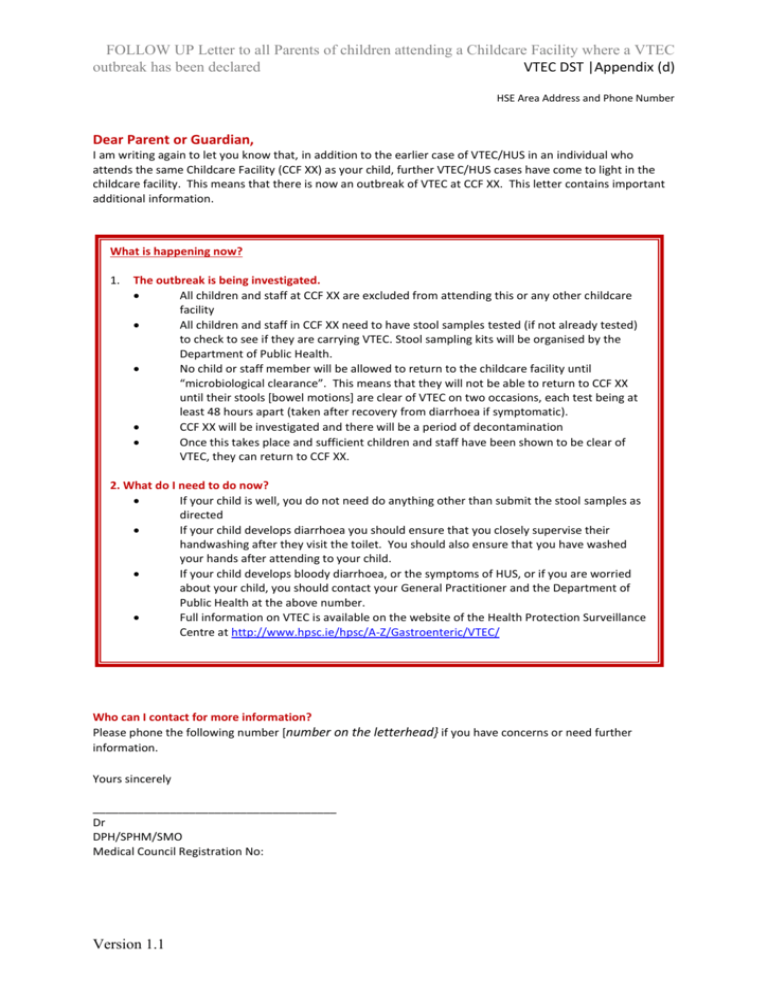
FOLLOW UP Letter to all Parents of children attending a Childcare Facility where a VTEC outbreak has been declared VTEC DST |Appendix (d) HSE Area Address and Phone Number Dear Parent or Guardian, I am writing again to let you know that, in addition to the earlier case of VTEC/HUS in an individual who attends the same Childcare Facility (CCF XX) as your child, further VTEC/HUS cases have come to light in the childcare facility. This means that there is now an outbreak of VTEC at CCF XX. This letter contains important additional information. What is happening now? 1. The outbreak is being investigated. All children and staff at CCF XX are excluded from attending this or any other childcare facility All children and staff in CCF XX need to have stool samples tested (if not already tested) to check to see if they are carrying VTEC. Stool sampling kits will be organised by the Department of Public Health. No child or staff member will be allowed to return to the childcare facility until “microbiological clearance”. This means that they will not be able to return to CCF XX until their stools [bowel motions] are clear of VTEC on two occasions, each test being at least 48 hours apart (taken after recovery from diarrhoea if symptomatic). CCF XX will be investigated and there will be a period of decontamination Once this takes place and sufficient children and staff have been shown to be clear of VTEC, they can return to CCF XX. 2. What do I need to do now? If your child is well, you do not need do anything other than submit the stool samples as directed If your child develops diarrhoea you should ensure that you closely supervise their handwashing after they visit the toilet. You should also ensure that you have washed your hands after attending to your child. If your child develops bloody diarrhoea, or the symptoms of HUS, or if you are worried about your child, you should contact your General Practitioner and the Department of Public Health at the above number. Full information on VTEC is available on the website of the Health Protection Surveillance Centre at http://www.hpsc.ie/hpsc/A-Z/Gastroenteric/VTEC/ Who can I contact for more information? Please phone the following number [number on the letterhead} if you have concerns or need further information. Yours sincerely ______________________________________ Dr DPH/SPHM/SMO Medical Council Registration No: Version 1.1 FOLLOW UP Letter to all Parents of children attending a Childcare Facility where a VTEC outbreak has been declared VTEC DST |Appendix (d) VTEC/HUS Information Sheet What is VTEC? Verotoxigenic Escherichia coli (or VTEC) are bacteria (bugs) found in the gut of many healthy farm animals. VTEC bugs produce a toxin (called verotoxin) that can produce a serious form of gastroenteritis in humans. Its most serious complication is Haemolytic Uraemic Syndrome (occurs in 5-10% of VTEC cases). What is HUS? HUS or haemolytic uraemic syndrome is a complication of VTEC infection in which red blood cells are destroyed, leading to anaemia (insufficient red blood cells or low haemoglobin), and sudden acute kidney failure. It requires intensive medical treatment. How do you catch VTEC? Because VTEC can be present in the gut of many farm animals, it is also present in animal’s faeces (i.e. manure, dung, slurry). For a human to be infected with VTEC, the bug has to be swallowed first. This can happen in a number of ways: by eating food which has been contaminated by animal or human faeces (undercooked or ready-toeat foods are most likely) by drinking inadequately-treated water which has been contaminated by animal or human faeces by coming in contact with farm animals or their faeces and then not washing hands before eating by coming in close contact with someone who is suffering from VTEC infection and then not washing hands before eating by touching objects inside (e.g. in the home or other setting where someone is suffering from VTEC infection) or outside (e.g. on a farm) that may have been contaminated with VTEC and then not washing hands before eating Contamination of their hands can allow the bacteria to spread when children share toys or play together. Careful hand-washing is the key to preventing spread of this infection. What are the symptoms of VTEC and HUS? VTEC: The main symptom of VTEC infection is diarrhoea, which can be severe (bloody in about half of cases). Bloody diarrhoea can be so severe that it may stain clothes and bedding. Bloody diarrhoea is a sign of more severe bowel inflammation. The toxin from the VTEC damages the lining of the bowel which leads to the bloody diarrhoea. The diarrhoea generally comes on between 4-7 days after the person has taken the VTEC into their body. Patients often have painful tummy cramps. . There is also loss of appetite and often a feeling of flu-like symptoms; aches and pains, tiredness and headache. While most people with VTEC develop symptoms, occasionally, there may be no symptoms – such individuals are ‘asymptomatic’. You should contact your own doctor if you are concerned. HUS If HUS develops, it generally does so about a week after diarrhoea starts (occasionally patients with HUS have no diarrhoea). The symptoms of HUS can be very non-specific, and may include tiredness, sleepiness, extensive bruising, unusual bleeding, swollen hands/feet/face, or passing little urine. You should contact your doctor immediately if you are worried or if any of these symptoms develop. If your child does not pass water for more than 12 hours you should bring him/her to your local Emergency Department. How is VTEC diagnosed? The VTEC bugs are detected in a stool (bowel motion) sample by the laboratory. If VTEC is identified, this means the child has VTEC infection. Is there a treatment for VTEC? The vast majority of cases of VTEC get better with no treatment and without hospitalisation. Drinking plenty of fluids is all that is needed. Occasionally, some children continue to pass VTEC in their stools for many, many weeks – such children may be referred to hospital for treatment of their chronic infection. Version 1.1 FOLLOW UP Letter to all Parents of children attending a Childcare Facility where a VTEC outbreak has been declared VTEC DST |Appendix (d) If my child has VTEC or HUS will s/he be ok? Most children with VTEC infection make a full recovery. The majority of children with HUS also recover fully and require only a short stay in hospital. Up to one quarter, however, will go on to have some damage to their kidneys. Early treatment of HUS is therefore very important. Version 1.1
